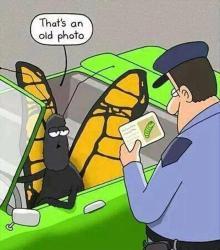You know, I was going to say you guys need to start pulling your weight around here. But then I was watching the Rays game and they said it was snowing in Detroit where the Yankees are playing the Tigers. So I will continue with the butterflies until spring arrives for the rest of you. My notion of "seasons" is very different than non-Floridians.

A few housekeeping issues before I get to the meat of my post. BAMONA said my Underwing Moth was an Ilia Underwing if that interests you. Also, I got egged again today. This time the culprit was a Long-Tailed Skipper on the butterfly pea.
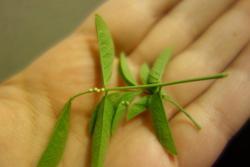
Okay, now we're going to have a lesson but I temporarily changed the plan. You see, today we're going to talk about Spicebush and Palamedes Swallowtails. As you saw, the other day I went out and may or may not have found a Spicebush (still pleading the Fifth). Well, I put him in a container with the Redbay leaf he was on, a Sassafras leaf, and some Spicebush leaves I accidentally broke off when searching for caterpillars. So he had quite the variety. But he would only eat that one Redbay leaf I brought him in on. Totally ignored the other plants. Now, I've never had trouble switching caterpillars' host plants. I give Sulphurs Cassia and Senna. I give Monarchs different kinds of milkweeds. I switch Long-Tailed Skippers from Desmodium spp. to Butterfly Pea. And they never care.
So I'm kind of scratching my head wondering why this Spicebush won't eat anything else offered him. Since I have nothing better to do today, or any day, I drove back to the unnamed place I found him and picked more leaves. And I found a new friend. Except this friend was different because it was a Palamedes Swallowtail caterpillar!
I've been going through a lot of my old photos to add to the plant database (thanks for the thumbs ups to those who noticed). And I was looking for Zebra Swallowtail photos because I will get back to that at some point. But today I looked for Palamedes photos. I know I haven't raised them very many times and only one at a time. From my photos, I think this is the fourth one I've found.
I have books that say the Palamedes will eat Sassafras and Spicebush, but here I've only ever seen them on Redbay or Swampbay (which are almost the same plant). All of these plants are in the Laurel family. There is a disease going around called Laurel Wilt disease which is killing off the Redbay and Swampbay trees. (It also kills Avocados which are in the same family.) This could be problematic for the survival of the Palamedes because I don't think they'll switch to other plants. I might try offering my caterpillar some Sassafras and Spicebush just to see what he does. But with Redbay in the same container, I think he'll ignore it.
The caterpillars of the Spicebush and Palamedes are very similar and they eat the same plant, so how do you tell the difference? Well, Melanie is here to show you. And scratch her head because I'm sure the first guy I found is a Spicebush but I've never met one so picky before. More on that later. Now, the caterpillars have two phases. Their first three (I think?) instars are spent looking brown and white to resemble bird poop. Then, they molt and enter their green phase where they are a snake mimic. But both phases have subtle differences. The first involves looking at the caterpillars' butt. Not kidding. I have so many pictures of caterpillar booties they could bust me for insect porn.

The Palamedes has a plain white butt while the Spicebush has a brown patch in the white on part of its butt. Behold...Palamedes on left, Spicebush on right in each pic.
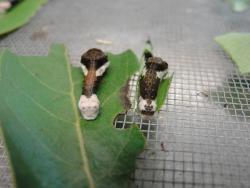
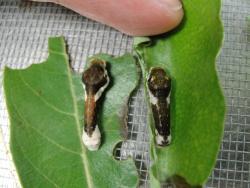
Sometimes the Palamedes' head looks bigger and as they grow, it definitely is. But sometimes it's just the way they sit so you can't always rely on that. Ok, here's a Palamedes butt again. Solid white.
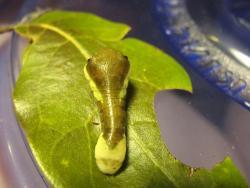
Now, once they turn green it can get a little trickier. But once you see them it gets easier. Basically, they both have the prominent eyespots we're used to seeing. But they have secondary spots behind those. In the Spicebush, they are much more developed and obvious, while in the Palamedes they are hardly noticeable. Also, the Spicebush has a circle inside the spot while the Palamedes doesn't. Again, Palamedes on the left, Spicebush on the right.
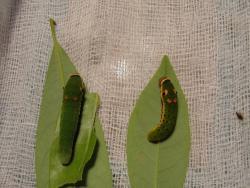
Here are some more pictures of Spicebush. Look at the spots behind the primary eyespots.
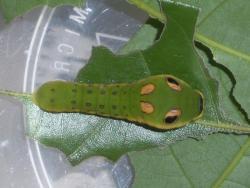
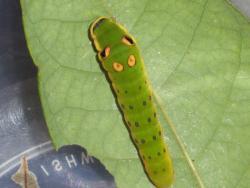
Now, here's a nearly full grown Palamedes. See how his secondary eyespots are much plainer and smaller? Also, they have much larger "heads" and are less streamlined than the Spicebush at this point. And just to give you an idea of size, I put one next to a double A battery.


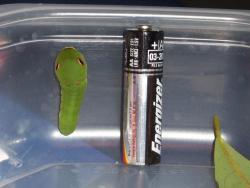
Here's the Palamedes I found today.
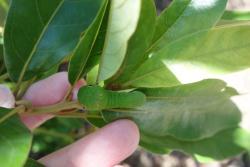
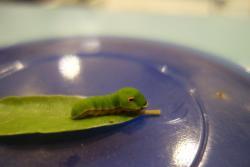
And here's my Spicebush that won't eat Spicebush. He definitely has brown on his butt, although it's not quite as prominent as I've seen on other caterpillars. And FYI, as soon as I put Redbay leaves in the container he started chowing down. He had eaten a good chunk of leaf by the time I drove home. Either he's really picky, he's going to molt into his green form and I'm going to get a surprise and learn something new, or I've got a mutant hybrid I'm going to demand they name after me.
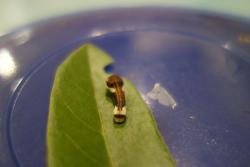
Okay, we've come this far and hopefully we've learned something. But I know some of you are like, "Melanie, I never find caterpillars. I just look for the butterflies." And I have something for you, too. Now, the Palamedes has a somewhat limited range. It's mostly a Southeastern butterfly but it's also present in parts of the Mid-Atlantic. The butterfly it is most confused with is the Eastern Black Swallowtail. First, let me just say that Palamedes are big butterflies, which is why the caterpillars are big. Also, because of their host plant choices, they are usually found in swamps and wetlands. One of their favorite nectar plants is Pickerel Weed. It's pretty rare that I see them in my yard. But when I do it's usually either right at the beginning of spring or in the fall. But if I go hiking in wetlands I tend to see them all the time.
Okay, let's start with the Eastern Black Swallowtail that most of us are familiar with. The dead giveaway for them is the "bullseye" cell they have at the bottom of their wings. They are the only ones that have a black dot inside the reddish-orange cell at the base of the lower wings. You can see it from the top or the bottom or side. Also, notice that their body is black with spots.
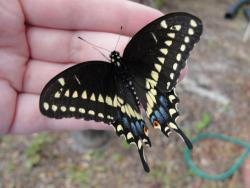

Now, the Palamedes has several differences but not all of them are easy to see unless it holds still and since when do butterflies do that?

First, Palamedes lack the spot I talked about on the Black ST. Also, they have yellow stripes on a black body as opposed to the spots on the Black ST. They also have a stripe on their underwing that runs parallel to their body. They are the only Swallowtail that has that. But if you're looking at them "on the fly", the Palamedes is larger and has what I call an "airbrushed" appearance. Notice how the yellow on their wings looks like someone airbrushed it on, whereas the yellow on the Black ST is very defined into shapes.
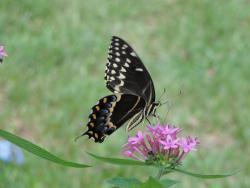
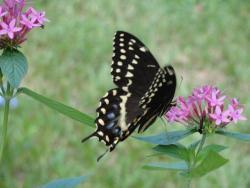
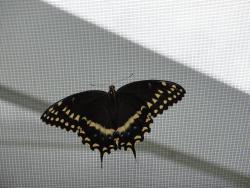
Now, let's just have some fun! Both the Spicebush and the Palamedes caterpillars are devoted students of yoga. No seriously, I think they do this to look more like a snake mimic. They'll even sway back and forth like a cobra, I swear! But this photo always makes me laugh. Pretty sure this is a Palamedes, FYI. It's hard to tell from the side.
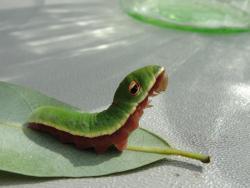
And I've seen this before, but someone posted it on Facebook today so I thought I'd share.
